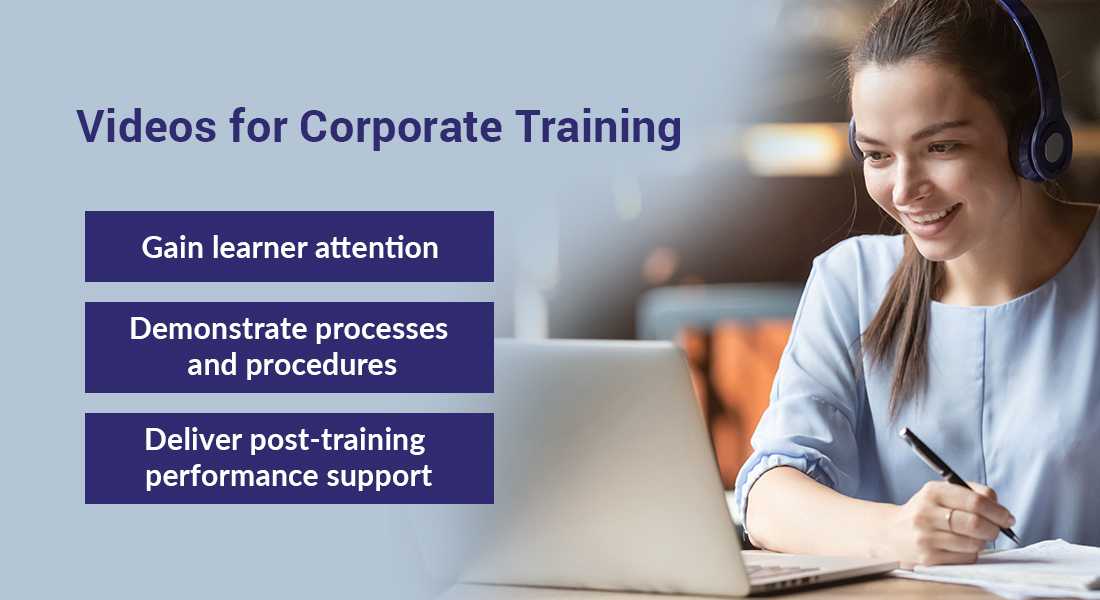5 Remarkable Reasons Using Videos Can Result in Exceptional eLearning Courses

To borrow a popular quote from Jane Austen, it is a truth universally acknowledged that a corporate learner undergoing a non-interactive and poorly designed training program must be in want of a good corporate learning experience. A constant challenge for L&D trainers is creating training that captivates learners and compels them to sit up, take notice, and learn. Using videos can be an extremely powerful training strategy.
What are the Benefits of Using Videos in eLearning?
Using videos in eLearning can help you:
- Gain learner attention in course introductions
- Demonstrate how-to processes and procedures without hassle
- Offer bite-sized learning combined with microlearning
- Meet the demands of the modern learner
- Deliver post-training performance support and daily reinforcement
Many companies incorporate videos in their eLearning courses to significantly improve their training results. Videos remain one of the most effective ways of involving learners in the learning process – they are cost-effective, easy to create, and more importantly, create excitement in the learner.
In this blog, we will look at five reasons to use videos in eLearning courses.
Why Use Videos in eLearning
1. Gain Learner Attention in Course Introductions
As per Gagne’s nine events of instruction, all instruction must begin with gaining the attention of your learners. This first step must act like a ‘stimulus’ that alerts learners of the learning to come.
Though eLearning course introductions are traditionally text-based, videos can be a better alternative that’s more appealing and engaging.
Think of how MOOCs (Massive Open Online Courses) such as Coursera, FutureLearn, and OpenX welcome their online learners to the course. All of them use videos with the instructor talking about the skills the learner will acquire from the training and how they will be able to put these skills to use after taking the courses.
Use videos to carefully construct course introductions that highlight the narrative arc of the course in an engaging way. Use a combination of images (photographs or drawings), memes, GIFs, animated characters, work environment backgrounds, and professional narration to situate the learning objectives in their specific contexts.
Some tips to get the best out of videos:
- Create small scenarios to highlight the challenges your training is going to address, how it relates to the real-world.
- Let the course instructor figure in the introduction video to add a human touch to the whole learning experience.
- Use videos to help the learner recall relevant prior knowledge that helps them connect the current training to earlier training sessions.
- Explain the learning objectives the course addresses with a ‘Before-After’ approach. This answers the “What’s in it for me?”, something most learners want to know before they jump into the training.
- Instead of directing the learner to a webpage (such as YouTube or Vimeo), embed the video right inside your course. This keeps the entire learning experience within the LMS (short for learning management system), which will offer you insights on learner engagement.
- Create a video for new hires with your senior management welcoming the newcomers to build a sense of belongingness and loyalty.
2. Demonstrate How-to Processes and Procedures Without Hassle
Take a step back and think of how you usually explain a procedure, policy, or process in your courses. How you would display:
- Dynamic data
- Moving parts of an equipment
- Chemical or physical reactions
- Assembling a piece of equipment
- A software debugging process
Bullet points and lists are usually used for instructions on how to perform a procedure or follow a process. Written explanations may be good entry points, but training on procedures and processes requires demonstrating the procedure or process being performed in the real world by real people. And videos are the perfect way to do that!
Videos are extremely useful in demonstrating skills requiring learners to recognize or copy movements (such as procedures and processes), making abstract concepts concrete, classifying and comparing information, etc. (Source)
Here are some examples of procedures and processes that can benefit from videos:
- Showing sales reps how to handle customer objections
- Explaining how to troubleshoot a failed system to service technicians
- Demonstrating how to operate a piece of machinery
- Describing how to qualify customers as prospects (i.e., the prospect qualification process)
3. Offer Bite-sized Learning Combined with Microlearning
Bite-sized or microlearning is the need of the hour!
Download our eBook on microlearning and how to make the most of it in your training!
Microlearning videos strike a neat balance between engagement and accessibility. Most companies use microlearning videos either as standalone (video-based) learning modules, or as a part of their eLearning courses.
Either way, combining microlearning (bite-sized) with videos (that combine text and image) is a very effective recipe for learner engagement – it is one strategy you must consider for your corporate training.
4. Meet the Demands of the Modern Learner
What’s the first thing that comes to mind when you think of millennials?
They are:
- Tech-savvy and know how to navigate the Internet
- Multitaskers who juggle between social media and learning seamlessly
- Always connected, with at least one mobile device with them at all times
In short, the millennial generation lives ‘online’, doing everything on their personal and powerful little devices called smartphones.
The U.S. labor force is saturated with millennials and it would be a huge mistake to ignore their unique learning characteristics. Videos, in that regard, are a special tool that can be used to appeal to your modern learners. They are mobile-friendly, shareable, and most importantly, do not put the learner to sleep.
Mobile devices also have great offline capabilities, allowing the learner to download and locally store files to use when there is no Internet connectivity. Short videos could be made available on the LMS, for instance, for remote learners to keep their skill sets up to date.
Videos are suitable for a wide variety of learning situations – both formal and informal:
- Pre-training (as course introductions, for example)
- During the training (as how-to videos for explaining complex procedures and processes)
- Post-training (as performance support tools; more on this later)
5. Deliver Post-training Performance Support and Daily Reinforcements
What’s the right format to refresh your employees’ learning when they are out in the field?
What kinds of performance support tools do you use to offer just-in-time support to your learners?
Performance support and refresher training in the format learners prefer is crucial for performance.
Videos for refreshment training and performance support
i. The goal of refresher training is to help learners retain their learning, and prevent them from becoming victims of the forgetting curve. Videos are one format that most modern learners are very comfortable with; they also have longer retention levels.
Use microlearning videos to capture the summary of the training in 2-3 minutes, and send them to the learners’ mobile devices periodically (via the LMS/portal). Include only need-to-know information to get straight to the point.
ii. Performance support is about offering the right information at the exact moment of need to help learners perform their jobs better. The trick is to offer content that is quick to understand and can be assimilated with minimum effort.
Provide how-to videos as performance support tools (PSTs) which learners can access on their mobile devices, with diagrams, flowcharts, and animations making the videos visually rich and informative.
A Bonus Tip
In addition to the different ways videos can be used in training, a very important advantage is that they can be very quick easily created and deployed using rapid authoring tools.
Today, trainers have a lot of options when it comes to software for video development. Panopto, PowToon, Adobe After Effects, Camtasia, and iSpring Suite all come with excellent screen-recording and editing capabilities.
However, rapid authoring tools too offer great support for video development and editing – and this is what most companies today tend to opt for owing to the twin benefits of developing eLearning courses and interactive training videos all in the same tool. Because it’s simply cost-effective.
Authoring tools such as Articulate Storyline, Adobe Captivate, and Lectora Inspire make life easy for trainers with their built-in templates and media libraries. These allow developers to create responsive videos (that can play on any digital device) that can include scenarios, simulations, and gamification. These videos can also be edited when changes are needed and delivered rapidly.
Note: Tools alone are not enough to create videos rapidly. You also need a team of skilled developers who know how to make the most of these tools. In case your in-house development team isn’t available or lacks the required capabilities, consider outsourcing!
Parting Thoughts
As you can see, videos for corporate training can offer a number of benefits. They come handy in almost all learning situations and for all sorts of trainings including sales, compliance, software, safety training, and many more. Make sure to integrate videos into your courses to make them exceptional and exciting for your modern learners!
Selecting a capable vendor who can develop videos for your eLearning courses can be a tricky business. Download our eBook ‘Outsourcing eLearning Design and Development’ and learn how to pick the right eLearning vendor for your video development and other training requirements!




![6 Types of eLearning Videos to Enliven Your Corporate Training! [SlideShare]](https://blog.commlabindia.com/hubfs/Imported_Blog_Media/elearning-videos-enliven-corporate-training-slideshare.png)
